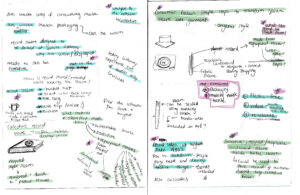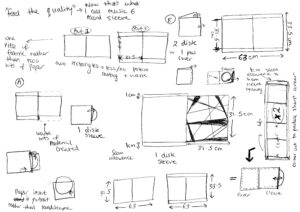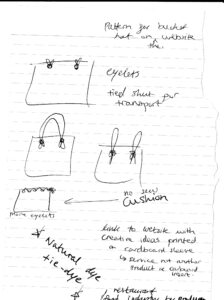Since the Industrial Revolution, technological progress has been rapid and unstoppable. A level of material comfort, previously unimaginable, has been created with endless products readily available to consumers at rock-bottom prices. However, the current linear ‘take-make-waste’ economy has its expiry date.
The Ellen MacArthur Foundation work with businesses, academia, policymakers and institutions to “accelerate the transition to a circular economy” on a global scale. Their three-part plan for a circular economy includes:
1. Design out waste and pollution.
2. Keep products and materials in use.
3. Regenerate natural systems.
As a Textile Design student, diving headfirst into an industry with one of the highest waste production rates in the world, I need to be cautious of what I produce. It is evident in the foundation’s work and beliefs that design sits at the heart of a circular economy. As designers, we have the position to redesign everything and reimagine the linear systems we have used over past centuries.
I found the ‘Circular Design Guide’ (linked on their website) to be particularly helpful in developing my understanding of the ways in which I can positively contribute towards creating a circular economy. For example:
• Instead of selling products, sell a service such as a subscription or online rental
• Extend the life of a product by designing products that last
• Safe and circular material choices
• Dematerialisation – i.e. creating a product using the minimal amount of physical material
• Modularity – i.e. designing a product that is upgradable and easy to repair
https://www.circulardesignguide.com/
Furthermore, as inhabitants of a planet that is diving headfirst into a climate emergency, we all need to be cautious of what we produce and consume. The end to ‘throwaway culture’ and shift to a system of regenerating materials with little to no waste; alongside a culture of transparency and accountability where all members of supply chains are paid living wage for working in safe, dignified conditions, sounds almost utopian. It is something we all agree should happen but do not act upon enough.
However, rather than dwell, feeling guilty about all the things in the world that you as a sole individual cannot put right this very second; recognise the power we all have to make positive change, big or small. Organisations such as ‘Fashion Revolution’ raise public awareness and educate people about the systemic challenges facing the global fashion industry. Through public protests, online resources and other events, they inspire people to consume less, value quality and take better care of their clothes. Initiatives such as ‘#haulternative’ aim to help people understand the impacts of their clothes and how they can influence the global fashion industry by shopping second-hand, swapping clothes with friends and DIY customisation.
https://www.fashionrevolution.org/wp-content/uploads/2019/02/FashRev_Haulternatives_2019.pdf

So, with the above research in mind, I now sit and think of the upcoming project – RETHINKING/REDESIGNING. The project provides an opportunity to be an adaptable and versatile designer exploring the role design has on the environment. We have been tasked with firstly selecting a technique we can explore, utilizing materials we already have in our home-studios and secondly, selecting a concept that sits in line with Fashion Revolution’s ideas and those of the ‘Circular Design Guide’.
My Concept and Context.
I started by looking at all the random things I have accumulated/hoarded in my new studio space (otherwise known as my bedroom). Amongst the piles of newspapers, trousers I have yet to alter and mouldy screen-print binders, I found a small selection of vinyl records. The collection consists of Now That’s What I Call Music 6, 99p from a charity shop, and various waltz arrangements, from ECA free-use-hub. Although I am a massive fan of records, I do not own a record player here in Edinburgh. Slightly counter intuitive I know; however, they did provide a spark of inspiration for this project.
The album cover is an integral part of a record. Not only does it project the product, the artwork is also designed to be held and admired whilst listening. But what if there was a way of further making music tactile whilst simultaneously creating zero-waste packaging for one of the music industry’s top seller products? (Due to lockdown, vinyl sales have been highest since the 1980s according to NME)

This is where my concept of a collectable and convertible textile album sleeve was born. As seen below in one of my sketch sheets, the net of a record sleeve is a rectangle – different dimensions depending on whether it is a single or double vinyl album. The consumer would be able to either a) follow simple steps to transform the rectangle of material into a reusable tote bag, cushion or pin to the back of a denim jacket or b) unleash their creativity and create garments, accessories ect. of their own design using the fabric.


Technique
Amongst the endless random objects in my studio, is my ever-growing collection of fabrics, all sourced from charity shops or deadstock. I think natural fibres such as calico, provide a good level of strength and structure to support the record whilst avoiding the use of synthetic, pollutant fabrics.
Initially, I plan on exploring natural dyes to create a tie-dye background on the canvas calico fabric. I am collecting food waste (onion skins, orange peels, avocado seeds and skins, turmeric and instant coffee) from myself and my flatmates, which I will boil down into dyes. This is a process I could see working on a commercial scale, working with restaurants etc.. to collect the waste from the food industry.
Finally, unique artwork (inspired by the album inside) added onto the hand dyed fabric would be done using a combination of techniques including hand painting, block printing, embroidery, applique and stencils. If produced on a commercial scale, the screen-printing technique: discharge printing would be used.
Stay tuned for more blog posts on this project, my random experiments and thoughts. Hopefully there is not too many grammatical errors along the way.
Also side note: I apologise for the quality of the photos of my sketch sheets in this post, my scanner has temporarily stopped working. I will hopefully be updated these images with clearer scans soon.
Thanks for reading 🙂
-H




Great first blog Hope.
Your analysis of the resources attached to this project reads well.
I am intrigued to find out how you will develop you idea and enjoyed the connection with utilising food waste too .
Once your scanner is working clarity in the drawn images will enable the viewer to understand your concept.